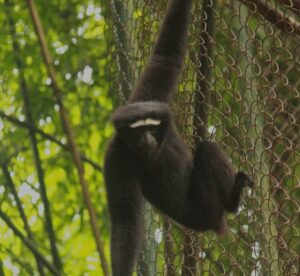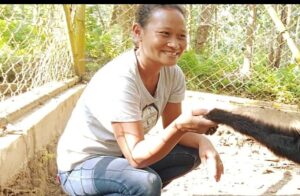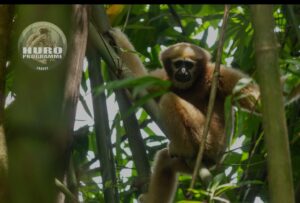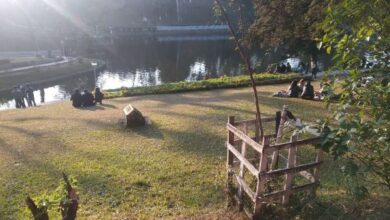
Shillong, June 16: A pressure group from Garo Hills has opposed shifting of Western Hoolock Gibbons from Sonja Wildlife Rescue Centre to upcoming State Zoo at Umtrew
In a letter to Chief Minister Conrad Sangma on Monday, A’chik Holistic Awakening Movement (AHAM) expressed concern over the move.
The reasons cited by AHAM below
1. Ecological disruption: The Western Hoolock gibbons, found exclusively in the western part
of Meghalaya, are an integral part of the Garo Hills’ ecosystem. Their presence helps
maintain the ecological balance by aiding in seed dispersal and maintaining forest dynamics. Relocating them to a different environment, such as Umtrew, could disrupt their natural behavior and negatively impact the local biodiversity of Garo Hills. Hoolock gibbons are a flagship species, which means by protecting them, we are also conserving their natural habitat along with several other ecologically significant species. Thus, gibbons play a major role in carbon sequestration and climate change mitigation. The purpose of the Sonja Wildlife Rescue Centre is to ensure that the rescued gibbons are rehabilitated until they are ready to return to the wild to perform their ecological services to Garo Hills. In the era of the anthropocene, gibbons are very crucial to India’s efforts towards climate change.
2. Stress and adaptation Issues: Western Hoolock gibbons are known for their specific habitat requirements and strong territorial behaviour. The stress of relocation and the need to adapt to a completely new environment can lead to severe psychological and physiological stress, which can be
detrimental to their health and well-being.

3. Conservation concerns: The Sonja Wildlife Rescue Centre has been specifically designed to cater to the needs of rescued Western Hoolock gibbons. It provides a sanctuary that closely resembles their natural habitat, ensuring their rehabilitation and conservation. Moving them to a zoo environment, which is primarily for public viewing, undermines the conservation efforts dedicated to these
endangered primates.

4. Unique characteristics of Western Hoolock Gibbons: Western Hoolock gibbons are unique to the western part of Meghalaya. They are distinguished by their unique vocalizations, which are critical for maintaining social bonds and territorial claims. They also exhibit complex arboreal behaviours that
are specific to the dense forest habitats of Garo Hills. Relocating them to a zoo would strip them of their natural environment, potentially leading to the loss of these unique behaviours and adaptations.
5. Violation of IUCN guidelines and Indian Wildlife Protection Act, 1972: The proposed exchange of Western Hoolock gibbons to the Guwahati Zoo and Lucknow Zoo contradicts the International Union for Conservation of Nature (IUCN) guidelines, which emphasize that endangered species should be kept in their natural habitat whenever possible. Furthermore, the Indian Wildlife Protection
Act of 1972 mandates the protection of wildlife and their habitats. Transferring the gibbons violates these principles and legal protections designed to ensure their survival.
6. Cultural significance: The Western Hoolock gibbons hold significant cultural value for the indigenous communities of Garo Hills. They are often seen as symbols of the rich natural heritage of the region.Relocating them would not only be a biological loss but also a cultural one, affecting the identity and heritage of the local communities. The Garo holds a deep and profound relationship with gibbons.
The “Huro,” as they call it, has been conserved for generations as it is a sacred animal. It is
a cultural icon for the Garo, and the ancestors regarded the Huro as ‘A’song Nokgipa, Burung
Nokgipa, and Chiga Nokgipa’—meaning they are believed to be the custodians of the land, forest and river. Thus, the Garo people have always understood the ecological importance of gibbons.
7. Only non-human ape of India: Gibbons are 96% genetically similar to humans. This means they are the closest relatives of human beings in India—the most populated and largest democracy in the world. The Sonja Wildlife Rescue Centre is the world’s only and India’s only rescue centre solely dedicated to the conservation of the Western Hoolock gibbon. Their goal is to ultimately ensure a
safer environment for both the gibbons and the A’chik community, as gibbons are also the heritage of our forefathers and the spirit of our hills.
8. The role of Sonja Wildlife Rescue Centre Established in 2008: The Sonja Wildlife Rescue Centre has played a pivotal role in the conservation of the Western Hoolock gibbon. Prior to the establishment of this centre, the Western Hoolock gibbon was on the verge of extinction due to habitat loss, hunting, and lack of awareness. Since its inception, the Centre has been instrumental in the rehabilitation and preservation of these gibbons, providing a safe haven that mirrors their natural habitat. The Centre has also been at the forefront of spreading awareness about wildlife preservation throughout the Garo Hills. Through educational programs and community outreach, it has educated
the local populace about the importance of protecting the Hoolock gibbons and other wildlife, fostering a community that values and actively participates in conservation efforts.
“Given these points, we urge you to reconsider the decision to shift the Western Hoolock
gibbons from the Sonja Wildlife Rescue Centre to the upcoming state zoo at Umtrew. Instead, we recommend bolstering the existing facilities at the Sonja Wildlife Rescue Centre to ensure the continued protection and conservation of these magnificent primates within their natural habitat.
We appreciate your attention to this matter and are hopeful that you will take the necessary steps to ensure the well-being of the Western Hoolock gibbons and the preservation of Garo Hills’ unique biodiversity”, AHAM said.







